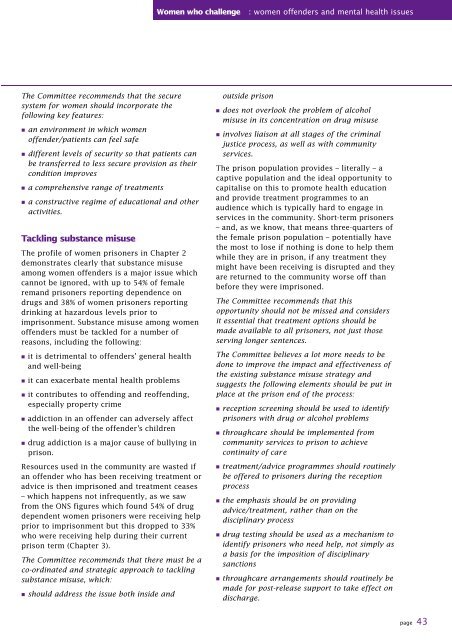Women who challenge - Nacro
Women who challenge - Nacro
Women who challenge - Nacro
- No tags were found...
Create successful ePaper yourself
Turn your PDF publications into a flip-book with our unique Google optimized e-Paper software.
<strong>Women</strong> <strong>who</strong> <strong>challenge</strong>: women offenders and mental health issuesThe Committee recommends that the securesystem for women should incorporate thefollowing key features:• an environment in which womenoffender/patients can feel safe• different levels of security so that patients canbe transferred to less secure provision as theircondition improves• a comprehensive range of treatments• a constructive regime of educational and otheractivities.Tackling substance misuseThe profile of women prisoners in Chapter 2demonstrates clearly that substance misuseamong women offenders is a major issue whichcannot be ignored, with up to 54% of femaleremand prisoners reporting dependence ondrugs and 38% of women prisoners reportingdrinking at hazardous levels prior toimprisonment. Substance misuse among womenoffenders must be tackled for a number ofreasons, including the following:• it is detrimental to offenders’ general healthand well-being• it can exacerbate mental health problems• it contributes to offending and reoffending,especially property crime• addiction in an offender can adversely affectthe well-being of the offender’s children• drug addiction is a major cause of bullying inprison.Resources used in the community are wasted ifan offender <strong>who</strong> has been receiving treatment oradvice is then imprisoned and treatment ceases– which happens not infrequently, as we sawfrom the ONS figures which found 54% of drugdependent women prisoners were receiving helpprior to imprisonment but this dropped to 33%<strong>who</strong> were receiving help during their currentprison term (Chapter 3).The Committee recommends that there must be aco-ordinated and strategic approach to tacklingsubstance misuse, which:• should address the issue both inside andoutside prison• does not overlook the problem of alcoholmisuse in its concentration on drug misuse• involves liaison at all stages of the criminaljustice process, as well as with communityservices.The prison population provides – literally – acaptive population and the ideal opportunity tocapitalise on this to promote health educationand provide treatment programmes to anaudience which is typically hard to engage inservices in the community. Short-term prisoners– and, as we know, that means three-quarters ofthe female prison population – potentially havethe most to lose if nothing is done to help themwhile they are in prison, if any treatment theymight have been receiving is disrupted and theyare returned to the community worse off thanbefore they were imprisoned.The Committee recommends that thisopportunity should not be missed and considersit essential that treatment options should bemade available to all prisoners, not just thoseserving longer sentences.The Committee believes a lot more needs to bedone to improve the impact and effectiveness ofthe existing substance misuse strategy andsuggests the following elements should be put inplace at the prison end of the process:• reception screening should be used to identifyprisoners with drug or alcohol problems• throughcare should be implemented fromcommunity services to prison to achievecontinuity of care• treatment/advice programmes should routinelybe offered to prisoners during the receptionprocess• the emphasis should be on providingadvice/treatment, rather than on thedisciplinary process• drug testing should be used as a mechanism toidentify prisoners <strong>who</strong> need help, not simply asa basis for the imposition of disciplinarysanctions• throughcare arrangements should routinely bemade for post-release support to take effect ondischarge.page 43
















